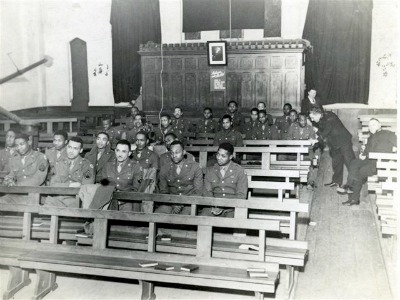From 30 September 1943 to 30 June 1944 a number of African-American US troops units were based at the County Ground in St Thomas. They were part of the overall US military presence in Exeter which included billeted troops and those based in Topsham Barracks. During this time US Army had a policy of segregating black and white troops which applied in the US and throughout the European and Pacific Theatres of war. In Exeter this meant that Black troops were based in tents in County Ground, St Thomas and white soldiers were based in soldiers quarters at Topsham Barracks.
The photo on the right was taken at Christmas 1944, in the Salvation Army Temple in St Thomas, which is now a karate club. We are very grateful to Ruth and Maurice Hawker, who passed the photo to us. This is the first photo we’ve seen of Black GIs in Exeter. The man on the right of the photo is Brigadier Didham, whose daughter inherited the photo.
You can read Maurice Hawker’s interview about his memories of the Black GIs.
The segregation that these men experienced was common practice throughout England where the US Army had an ‘Off Limits’ policy that kept black and white soldiers separated, both on base and in off duty social settings. In some towns this meant that ‘commanding officers would declare town “X” as out of bounds for Negro soldiers and town “Y” for white soldiers. In sparsely settled regions, where there were few towns, and most of them small, recreational facilities consisting usually of only a pub or two and a moving picture theater, a system would be set up for whites on “odd” nights and Negroes on “even” nights’.
In Exeter, the ‘off limits’ rule meant that the city was essentially divided in two. Black soldiers were allowed in St Thomas and West Exe. White soldiers were allowed in the city centre. While US soldiers were stationed in Exeter, the US Army placed Military Police, 1 black and 1 white, on either side of Exe Bridges to ensure that black and white soldiers did not cross to the other side. They coordinated patrols around the city to collect anyone who had strayed.
Black American Army Troops based in Exeter included the following battalions:
36 Station Hospital, Detachment of Patients
519 Quartermaster Truck Regiment HQ & HQ Detachment
595 Quartermaster Laundry Company
519 Quartermaster Group, HQ & HQ Detachment
595 Quartermaster Laundry Company, 2 & 3 Platoons
963 Quartermaster Service Company
Exeter’s ‘colored troops’ as they were known, were quite typical of the types of the assignments that were given to Black Americans in the war. Despite the promises of recruitment films like ‘The Negro Soldier’ which promised opportunities of frontline glory and officer training, almost 40% of the nearly 1 million Black American servicemen and women who contributed to the war effort were working in these ‘Quartermaster’ groups, doing unglamorous but necessary work of moving troops’ supplies, providing food, managing transportation, fuel and clothing for black and white troops. In Exeter this included running the US Food Depot at the Cattle Market in Marsh Barton.
In an interview for the BBC’s WW2 People’s War, Hilda May Eastley of Exmouth remembered, “Yanks also took over the Cattle Market in Exeter. Father was very shocked at these huge dark men, the first he had ever seen, and he touched his cap very respectfully, much to the amusement of the young GIs. Never had they such respect! It seemed an unreal time, we would never be the same again.”
Find out more about the Black GIs on researcher Crystal Carter’s pages.
Read about Black GIs at Mardon, near Moretonhampstead, on this fascinating blog page.

